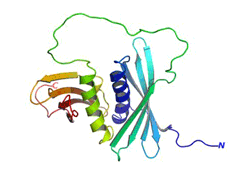
| Serial No. | GA-P0002HU |
| Species | Human |
| Specification | 0.1 mg/0.2mg |
| Brand | GenAsia |
| Origin | Shanghai |
| Price | US$350/US$620 |
Detailed information
1 Host: Escherichia coli (E. coli)
2 Species: Human
3 Protein Type: Recombinant
4 Synonyms: VGR, VGR1, Vgr1, D13Wsu115e, BMP6, zgc:113595, vgr, vgr-1, vgr1
5 Purity: 95% by SDS-PAGE
6 Application: WB、 Elisa、 Functional Studies
7 Background:
BMPs (bone morphogenetic proteins) belong to the TGF-beta superfamily of structurally related signaling proteins. As implied by their name, BMPs promote and regulate bone development, growth, remodeling and repair, in both prenatal development and postnatal growth of eye, heart, kidney, skin, and other tissues. Recombinant human BMP-6 produced from E. coli contains a mixture of monomer (15 kDa), dimer (30 kDa), and multimers. The dimer is an active polypeptide chain containing 2X142 amino acid residues.
8 Storage&Stability:
Avoid repeated freeze and thaw cycle.Store at 2-8℃ for delivery and store at -20 or -70℃ for future use. The loss rate of the target protein which describes the stability was determined by accelerated thermal degradation test.That is to incubate the protein at 37℃ for 48h and no obvious degradation and precipitation were observed.The loss of this protein is less than 5% within the expiration date under appropriate storage condition.
2 Species: Human
3 Protein Type: Recombinant
4 Synonyms: VGR, VGR1, Vgr1, D13Wsu115e, BMP6, zgc:113595, vgr, vgr-1, vgr1
5 Purity: 95% by SDS-PAGE
6 Application: WB、 Elisa、 Functional Studies
7 Background:
BMPs (bone morphogenetic proteins) belong to the TGF-beta superfamily of structurally related signaling proteins. As implied by their name, BMPs promote and regulate bone development, growth, remodeling and repair, in both prenatal development and postnatal growth of eye, heart, kidney, skin, and other tissues. Recombinant human BMP-6 produced from E. coli contains a mixture of monomer (15 kDa), dimer (30 kDa), and multimers. The dimer is an active polypeptide chain containing 2X142 amino acid residues.
8 Storage&Stability:
Avoid repeated freeze and thaw cycle.Store at 2-8℃ for delivery and store at -20 or -70℃ for future use. The loss rate of the target protein which describes the stability was determined by accelerated thermal degradation test.That is to incubate the protein at 37℃ for 48h and no obvious degradation and precipitation were observed.The loss of this protein is less than 5% within the expiration date under appropriate storage condition.








